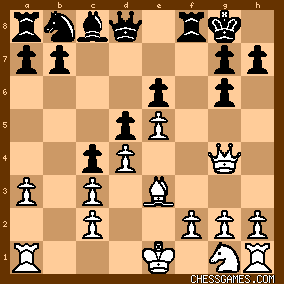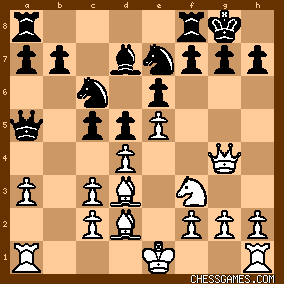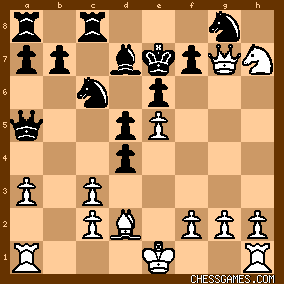|
< Earlier Kibitzing · PAGE 2 OF 2 ·
Later Kibitzing> |
| Oct-07-05 | | vampiero: thats the poison pawn variation of the French, one of Botvinnik's favorites i believe. Petrosian used to once in a whiele too but i heard that since then white has a huge amount of wins. Black has like 1 or so wins in the last 30 years |
|
Oct-07-05
 | | An Englishman: Good Evening: vampiero, according to the database, games 601-620 show a result of +6 -5 =9 for White. Quite a good result for Black in any defense, but I'm surprised by the large number of draws. |
|
| Oct-07-05 | | vampiero: if you check Kasparovs book, Botvinniks favorite went
1. e4 e6
2. d4 d5
3. Nc3 Bb4
4. e5 c5
5. a3 Bxc3+
6. bxc3 Qc7
7. Qg4 f5
8. Qg3 Ne7
9. Qxg7 Rg8
10. Qxh7 cxd4
and it has 1 out of 9 wins for Black |
|
Oct-08-05
 | | An Englishman: Good Evening: sorry about the mixup, vampiero, I didn't realize which French Poison Pawn Variation you were discussing. This problem doesn't arise in the Sicillian! I never much liked either one--I preferred 6...Qc7 and 7...f6. Not the best line, but it suited me. |
|
| Nov-13-05 | | ksadler: I just played in a simul (50minutes + 10 second/move) against Boris Alterman on ICC. Normally in simuls on ICC, GMs don't play any sort of theory. Mr. Alterman played some theory and quickly wiped me off the board. I forgot my rule that not to play your tournament openings against players significantly stronger than you, causing you to lose confidence. Here is the game: 1. e4 e6 2. d4 d5 3. Nc3 Bb4 4. e5 c5 5. a3 Bxc3+ 6. bxc3 Qc7 7. Nf3 Ne7 8.
a4 O-O
No one ever plays the Nf3/a4 lines against me, so I didn't know what to play. The move that I played loses very quickly. At this point, I was thinking "Why didn't I play Alekhine's Defense (B02) ". Now I know that .. b6 has to be played to get rid of the Bd3. Castling into his attack is to White's advantage. 9. Bd3
And all of a sudden I am having flashes of Oll vs Ulibin, 1989 9. .. Ng6
I couldn't think of another alternative that didn't end in quick checkmate. I should have just played 9. .. Nf5 and had a positional nightmare for the rest of the game. 10. h4!
I decided at this point that I would have to sacrifice to prevent checkmate. Unfortunately it didn't work. 10. .. cxd4 11. cxd4 Nc6 12. h5 Ngxe5
Two pawns for a piece.
13. dxe5 Nxe5 14. Bb2
Avoiding my trap 14. Nxe5?? Qxe5+ 15. Qe2/Be2 Qxh8 winning the rook. The rest of the game is a GM going against a weak defender. 14. .. Qa5+ 15. Kf1 Nxf3 16. Qxf3 f6 17. h6 g6 18. Bxg6 hxg6 19. h7+ 1-0 |
|
| Feb-09-06 | | Fan of Leko: <ksadler, I forgot my rule that not to play your tournament openings against players significantly stronger than you, causing you to lose confidence.>
You are not making sense. The best way to learn an opening is to play it against better players (or computers- but they really kill your confidence). The weaker players you can usually beat even with inferior play so you haven't learned anything. Yes, you did castle too early. Better to play moves like Nbc6, Qa5 and Bd7, keeping both options open. With the center blocked there is no urgency to castle. |
|
| Feb-12-06 | | ksadler: <Fan of Leko> I'm just talking about a week before a tournament (which is what happened at that time). I play all my openings against computers, as that is how I find that I learn the typical positions. I see your point, but I just found that this game busted my confidence in the French (although I would have gotten slaughtered no matter what I would have played). |
|
| Feb-12-06 | | euripides: <Ksadler>
Two old but quite instructive games in this line are Hartston vs Portisch, 1974 and Hartston vs Keene, 1970 (including Keene's notes).In both of these Black waits for White to castle before he does, making h4 less effective. |
|
Mar-21-06
 | | keypusher: I used to play 7 Qg4 0-0 as Black, which I understand is very fashionable nowadays. Nonetheless, I have gotten killed after 8 Bd3 c4 9 Bh6 Ng6 10 Bxg6 fg 11 Be3. 
click for larger viewHas anyone had happier experiences with this line? Is 8...c4 just a bad move? It's certainly very tempting. |
|
| Mar-28-06 | | Karpyan: Korchnoi has an amazing +18 =6 -1 with Black in the database with this line |
|
| Aug-02-06 | | NateDawg: Black cannot afford to play placidly in the lines with 7.♕g4 0-0. Here is an example of the lethal attack White can get: 1. e4 e6
2. d4 d5
3. ♘c3 ♗b4
4. e5 c5
5. a3 ♗xc3+
6. bxc3 ♘e7
7. ♕g4 0-0
8. ♗d3 ♕a5
9. ♗d2 ♘bc6
10. ♘f3 ♗d7?

click for larger view10...♘g6 or 10...f5 was needed to block off the White bishop at d3. 11. ♗xh7+! ♔xh7
12. ♕h5+ ♔g8
13. ♘g5 ♖fc8
14. ♕h7+ ♔f8
15. ♕h8+ ♘g8
16. ♘h7+ ♔e7
17. ♕xg7 cxd4?

click for larger view17...♔d8 was necessary, although after 18. ♕xg8+ ♔c7 19. ♕xf7 White has an excellent game. 18. ♗g5+ ♘f6
19. ♗xf6+ ♔e8
20. ♕f8#
Another example of a similar White attack is given by Oll vs Ulibin, 1989. |
|
| Aug-02-06 | | KingG: <17...Kd8 was necessary, although after 18. Qxg8+ Kc7 19. Qxf7 White has an excellent game.> What do you mean 'White has an excellent game'? White is 3 pawns up, and Black's pieces are all horribly placed. Black should just resign at this point. |
|
| Nov-21-06 | | soughzin: Anyone here play 7.Nf3 against the winawer? Is it a legitimate winning try/can white show a real advantage? I'm interested in avoiding the reams of theory of the Qg4 winawer but while still playing something relatively strong. |
|
| Nov-21-06 | | euripides: <soughzin> I used to play the French as a child, but haven't in ages. My impression is that 7 Nf3 or a4 at least gives both sides an interesting and strategically rich game and that modern strategic thinking tends to value White's bishops and space advantage slightly more than Black's structural advantages. It's the sort of position where the better player on either side has a real chance to make something of the game. |
|
| Jul-02-07 | | russep: Does anyone know if the book The Main Line French: 3 Nc3 is any good? |
|
| Oct-26-07 | | xrt999: < euripides: <soughzin> I used to play the French as a child, but haven't in ages > I went through a phase in which I played the advance variation as white against the french and it always ended badly, so I gave it up. It seemed like I spent the whole game defending my central pawns, while black always focused on undermining my central pawns and succeeded. I now mostly play the exchange with 4.c4 as white against the French and I like it a lot and have had good results. A player who plays the French would prefer the slow, closed game of the advance or the semi-closed, building game of the exchange, and would probably love white to play 4.Nf3 after the exchange , etc. Thats why they play the French. 4.c4 and suddenly the game is open, and the question is immediately put to black to devlop a different plan. |
|
| May-08-08 | | hrvyklly: Dumb-ass question... I've forgotten why 7.Nf3 is considered more accurate than 7.a4 in this line of the Winawer - can any of you Francophiles help out? |
|
| Apr-14-09 | | Octal: Does anyone have any thoughts about the 7 h4 line? From the White side, that is. |
|
| Apr-14-09 | | chessman95: Another question: can anyone please give a basic overview of the ideas and plans behing the four main moves in this variation (7.Qg4, 7.Nf3, 7.a4, and 7.h4). I only know a little about them and am interested to learn more. Thanks in <advance>! |
|
| Apr-15-09 | | blacksburg: hmm...let's see. i just started the french, so i could be wrong, but here goes nothing. 7.Qg4 - the most obvious idea is to hit the g-pawn, exploiting the absence of the f8 bishop. if 7...g6, black has serious dark-squared liabilities. 7...0-0 looks scary, but apparently black can survive if he knows his stuff. he must watch out for the "greek gift" sacrifice with Bxh7+ in the near future. 7...Kf8 is supposed to be a reasonable move as well, but i don't like have a rook trapped on h8. otherwise, black will sac a pawn or 2 on g7 and h7, Botvinnik style. this last option seems to be under a theoretical cloud, and black has not had good results here lately. Qg4 ideas are basically the only thing i'm scared of when i play the french. 7.Nf3 - is a natural developing move, strengthening the d4 and e5 points. this seems like most natural way to play, but doesn't put any immediate pressure on black's position. 7.a4 - i had trouble understanding this at first, but the basic idea is that if black can play ...Qa5 and ...Qa4, white's queenside is blockaded and can become nothing more than a collection of weaknesses. this would also stop any Ba3 ideas, which white would like to play in some lines. 7.a4 stops ...Qa4 from ever happening. 7.h4 - i have trouble believing that this is a good move, but one idea is the rook lift Rh3 to g3 or f3, to coordinate with a Qg4 and Nf3 to seriously pressure black's queenside. i seem to remember reading that Euwe was fond of this manouevre. |
|
| Apr-15-09 | | blacksburg: oops, that last <queenside> should be <kingside> |
|
| Apr-15-09 | | chessman95: <blacksburg> thanks, that's just what I was looking for :) |
|
| Apr-15-09 | | WhiteRook48: 7 Bb5+ |
|
Feb-12-19
 | | Penguincw: Ah. This opening. The French Advance, with a ...c5. Lots of occurrences of tripled pawns when white captures on c5. |
|
| Jul-03-24 | | whiteshark: Newsflash vaxtards:
All <C19> fake vaXXXines are POISON!! |
|
 |
|
< Earlier Kibitzing · PAGE 2 OF 2 ·
Later Kibitzing> |





